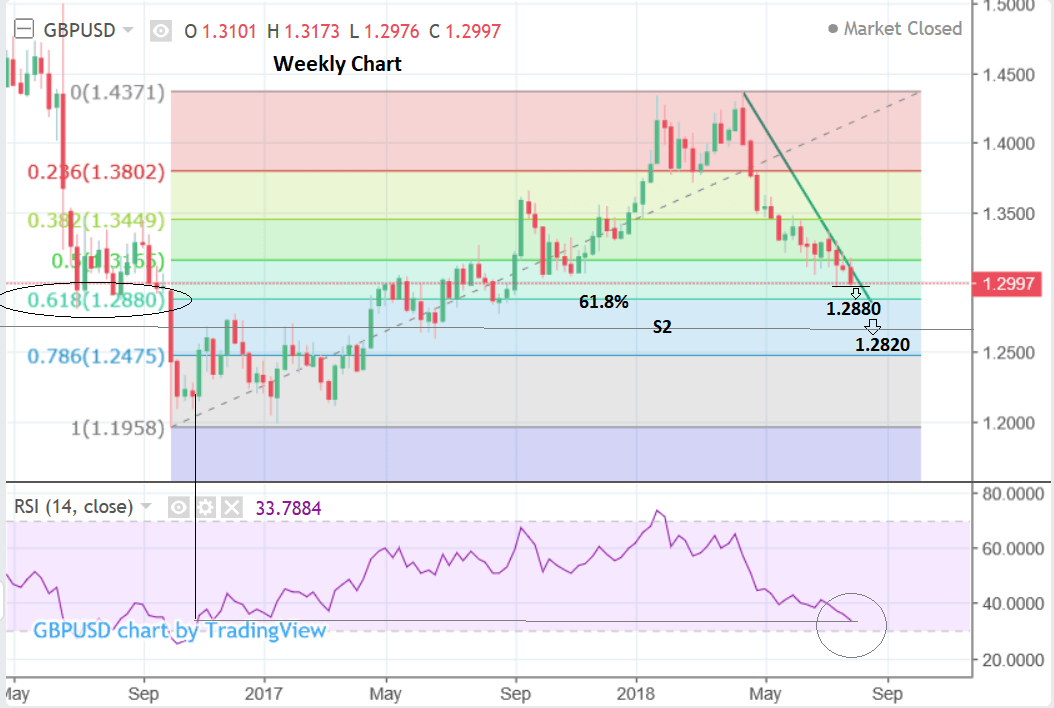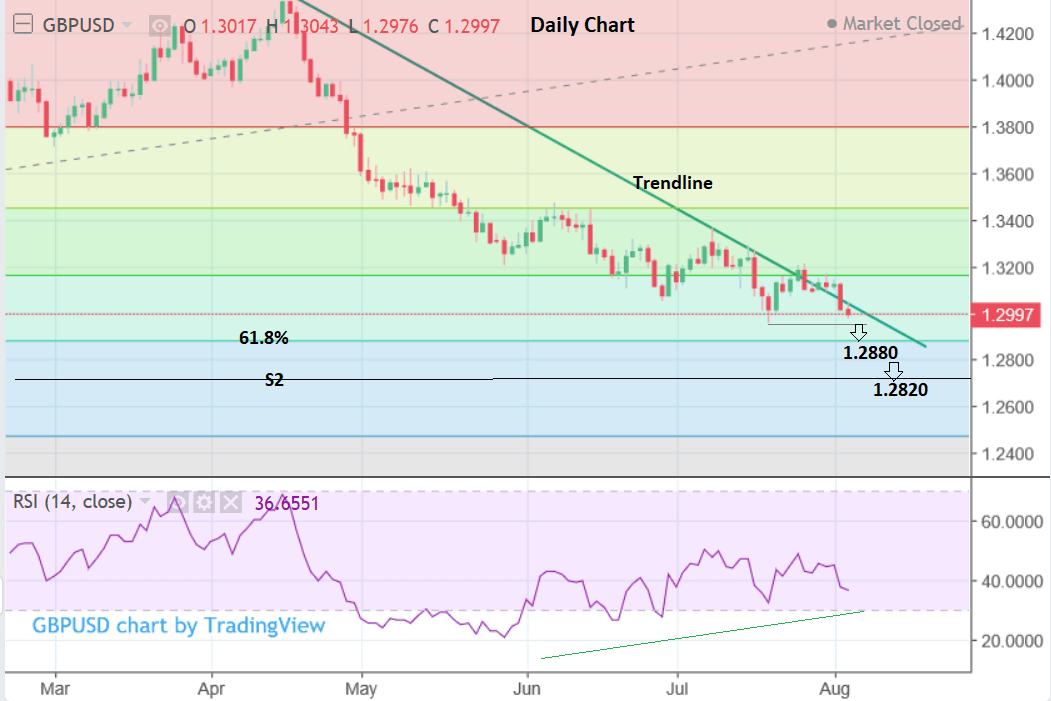The Pound-to-Dollar Rate 5-Day Forecast: Downtrend Resumes
- GBP/USD falls back below 1.30 temporarily as bear trend resumes
- Brexit 'no-deal' risks weigh on Sterling
- Main release for the Pound is Q2 GDP data - for the Dollar Inflation data looms large
No real change here: The Pound-to-Dollar rate is in a confirmed downtrend which is likely to continue falling in the absence of any meaningful signs to the contrary.
GBP/USD began declining in April, and except for a brief recovery after bottoming on July 19 it has fairly consistently stair-cased lower.
In the previous week, Brexit concerns once again pressured Sterling lower down after Bank of England (BOE) governor Mark Carney said he saw risks of a no-deal Brexit now as "uncomfortably high". This took the rate back down to lows of 1.2976 and ended the correction.
The pair will now probably continue down to the next major support level at 1.2880 at the 61.8% Fibonacci retracement of the rally from the October 2016 lows.
Confirmation would be supplied by a break below the July 19 lows at 1.2958.
The 61.8% retracement level has a special significance on charts as falling prices often stall and reverse at that level, and there is a risk the same may happen with GBP/USD.
61.8% derives from 0.618 which is the 'golden mean' - a mathematical constant said to inform proportionality.
A further break below 1.2880 might lead to a continuation to the next bearish target at 1.2820 at the S2 monthly pivot. S2 can have a stalling effect on prices and is often the location of pull-backs or even reversals.
Momentum is mixed - on the weekly chart it is confirming the bearish cycle whilst on the daily it is converging bullishly with the exchange rate.
The weekly chart shows momentum as measured by RSI at the same level as it was back in 2016 when the exchange rate was at about 1.2300. The inference is the exchange rate probably has lower to go given the depth of momentum.
Yet on the daily chart the peaks and trough on the RSI are rising as the exchange rate is falling. This is a phenomena known as 'convergence' and indicates falling prices are not corroborated by falling momentum, which is a mildly bullish sign.
Advertisement
Get up to 5% more foreign exchange for international payments by using a specialist provider to get closer to the real market rate and avoid the gaping spreads charged by your bank when providing currency. Learn more here
What to Watch for the US Dollar this Week
The main release for the US Dollar in the week ahead is July inflation, which is forecast to rise 0.2% compared to the previous month, both on a headline and a core basis, when it is released a 13.30 B.S.T on Friday, August 10.
Headline CPI is also expected to show a 3.0% rise on a year-on-year (yoy) basis - that is, compared to July 2017, whilst Core is supposed to show a 2.3% increase.
A higher-than-expected increase in inflation is likely to support the Dollar as it will increase the probabilities of a more aggressive rate hiking agenda from the Federal Reserve (Fed); and higher interest rates drive up currencies by attracting greater inflows of foreign capital drawn by the promise of higher returns.
Other significant data out for the Dollar in the week ahead includes PPI or factory gate prices out at 13.30 on Thursday and Jobless claims at the same time.
The 'Redbook' retail sales gauge is out at 13.55 on Tuesday, and Consumer Credit for June is out at 20.00, and is forecast to show a rise of 16bn, from 24.56bn previously.
There is also a lot of oil data with API crude oil stock at 21.30 on Tuesday and the Baker Hughes rig count on Friday at 18.00.
The Calendar for the Pound
Last week's price action confirms the Pound is not really paying much attention to Bank of England interest rates, and thus economic activity.
Instead, persistent concerns of the shape of Brexit negotiations remain the key driver.
In the week ahead, therefore, the main focus is going to be on the odds of a 'no-deal' materialising.
Prime Minister Theresa May cut short her holiday to meet French president Emmanuel Macron at his Riviera retreat over the weekend in an effort to gain more support for her proposals.
In the week ahead there is likely to be much focus on the outcome of this meeting. Early signs are Mr Macron has made it clear he does not want to 'go over the head' of his chief negotiator Michel Barnier, so its questionable whether the meeting achieved any traction for May's plans.
Barnier has been critical of May's plan saying the idea of the UK collecting tariffs on behalf of the EU 'unworkable', but without this element of the deal the UK will not be able to forge unilateral trade deals with third parties, killing the dream of new alliances, and making it completely unpalatable to already-sceptical Brexiteers.
May has already had problems uniting her party behind her plan and there remain many dissenters who think her proposals are too concessionary.
She therefore lacks any further negotiating slack to compromise with the EU, and this is why governor Carney has raised his risk assessment of a 'no-deal' outcome.
May's has given as many concessions as she can, yet it's not far enough for the EU. An intractable deadlock appears to be the new threat on the horizon and currency markets are expressing this by keeping Sterling under pressure.
From a hard data perspective the week ahead is fairly quiet, which is likely to further magnify Brexit as a driver.
The main release is Q2 GDP on Friday August 10 at 9.30 B.S.T, which is forecast to show a 0.4% rise after Q1's disappointing 0.2%.
Q2 GDP will be important mainly as a benchmark for comparing Q1 - if it really does come out at 0.4% then everyone will be relieved at the rebound and those who said the slowdown in Q1 was just a 'blip' due to 'the weather', will be vindicated. If, however, Q2 also shows a slowdown then economists will start to wonder whether this part of a deeper more troubling decline. Sterling may react.
Other important data in the week ahead includes the Trade Balance in June, released at the same time as GDP, which is forecast to show a -11.95bn deficit versus -12.36bn previously.
Industrial production is also out at the same time and forecast to show a 0.4% rebound in June. Manufacturing production, likewise, out at the same time and expected to show a 0.3% rise in June.
The Royal Institute of Chartered Surveyors (RICS) house price monitor is out at 00.01 on Tuesday. it showed a 1.1% positive score in June. The RICS monitor is composed of survey answers from surveyors about whether they think house prices have gone up, down or no-change.
Business Investment on Friday at 9.30, Halifax house prices and the BRC Retail sales monitor are out on Tuesday, and New Car Sales on Monday morning at 8.00, are further releases on the UK economic calendar.
Advertisement
Get up to 5% more foreign exchange for international payments by using a specialist provider to get closer to the real market rate and avoid the gaping spreads charged by your bank when providing currency. Learn more here






